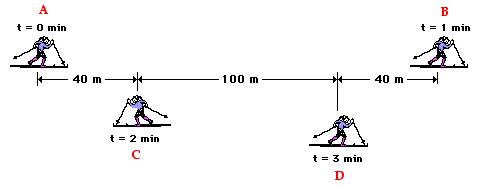Speed and Velocity
Just as distance and displacement have distinctly different meanings (despite their similarities), so do speed and velocity. Speed is a scalar quantity that refers to "how fast an object is moving."
Speed can be thought of as the rate at which an object covers distance. A fast-moving object has a high speed and covers a relatively large distance in a short amount of time. A slow-moving object has a low speed and covers a relatively small amount of distance in a short amount of time. An object with no movement at all has a zero speed.
Velocity is a vector quantity that refers to "the rate at which an object changes its position." Imagine a person moving rapidly - one step forward and one step back - always returning to the original starting position. While this might result in a frenzy of activity, it would result in a zero velocity.
Because the person always returns to the original position, the motion would never result in a change in position. Since velocity is defined as the rate at which the position changes, this motion results in zero velocity.
If a person in motion wishes to maximize their velocity, then that person must make every effort to maximize the amount that they are displaced from their original position. Every step must go into moving that person further from where he or she started. For certain, the person should never change directions and begin to return to the starting position.
Calculating Average Speed and Average Velocity
The average speed during the course of a motion is often computed using the following formula:
In contrast, the average velocity is often computed using this formula
Let's begin implementing our understanding of these formulas with the following problem:
Q: While on vacation, Lisa Carr traveled a total distance of 440 miles. Her trip took 8 hours. What was her average speed?
To compute her average speed, we simply divide the distance of travel by the time of travel.
That was easy! Lisa Carr averaged a speed of 55 miles per hour.
She maynot have been traveling at a constant speed of 55 mi/hr. She undoubtedly, was stopped at some instant in time (perhaps for a bathroom break or for lunch) and she probably was going 65 mi/hr at other instants in time. Yet, she averaged a speed of 55 miles per hour. The above formula represents a shortcut method of determining the average speed of an object.
And now a little Acceleration....A SPEEDY REMINDER...
According to Newton's first law, an object in motion continues in motion with the same speed and in the same direction unless acted upon by an unbalanced force. It is the natural tendency of objects to keep on doing what they're doing. All objects resist changes in their state of motion. In the absence of an unbalanced force, an object in motion will maintain its state of motion. This is often called the law of inertia.
So speed and velocity are governed by laws..
If the car were to abruptly stop and the seat belts were not being worn, then the passengers in motion would continue in motion. Assuming a negligible amount of friction between the passengers and the seats, the passengers would likely be propelled from the car and be hurled into the air. Once they leave the car, the passengers becomes projectiles and continue in projectile-like motion.
Now perhaps you will be convince of the need to wear your seat belt. Remember it's the law - the law of inertia.
Thanks to, © 1996-2010 The Physics Classroom
Can you do this one?
The diagram below shows the position of a cross-country skier at various times. At each of the indicated times, the skier turns around and reverses the direction of travel. In other words, the skier moves from A to B to C to D.Use the diagram to determine the average speed and the average velocity of the skier during these three minutes.

Show your work and explain your answer for Bonus!
Comments box is open..
What do you think of this post?
Did it help?
How so ?


The skier has an average speed of
ReplyDelete(420 m) / (3 min) = 140 m/min
and an average velocity of
(140 m, right) / (3 min) = 46.7 m/min, right
MR V's answer...is it right?
Mr. V i can not see the time for position B. Do you know what it says?
ReplyDelete- Savanah Yellow
Is the time 1? I'm not sure.
ReplyDelete- Savanah Yellow
I liked the rest of the blog. The animations help me alot because I am a visual learner. It helps me picture processes better.
ReplyDeleteOne thing I am not so sure about is the question about the skier. Does he move all the way from A to B then from B to C and from there to D? There are to many arrows for me to comprehend which arrow comes first.
- Savanah Yellow
Savanah, I have shrunk the picture on the blog..can you see all of it now?
ReplyDeleteYes the time is 1
He moves from A to B turns goes to C turns goes to D..
That help?
2 points for pointing out that the picture might not be totally visible on some computers.
Yes sir I see the full picture now. Thank you for making the arrows clear for me.
ReplyDelete- Savanah yellow
hey Mr.V the example of calculating the average helps the questions we had in class!!!! And i like the examples of inertia for the class project. I also will see if theres information that helps our hw!!! Thank you for the informations!!!!! Sabrina B./Yellow
ReplyDeleteYou are welcome. I appreciate letting me know what helps my kids so tha I can do more of it.
ReplyDeletePut a point in the bonus box.!!
Savanah , you are welcome.
ReplyDeleteMr V., what unit would you use when you have calculated the average speed?
ReplyDeleteLarry, yellow.
Mr V , tonights homework, the select a scientist, we have to pick one tonight correct? Can you have two or three choices and ask you which one we should pick tomorrow?
ReplyDelete- Savanah Yellow
NO you just have to decide if November 10 due date is enough time..
ReplyDeleteThere are a lot of scientists in your home text... look through it for ideas..
Larry, it depends on what units you used to measure the distance and the time...
ReplyDeletemeters per second? meters per hour?
Use the "distance" per "time" units.
Mr. V, I want to do a scientist but I'm not sure if he has a book. Can I ask you on Monday, if he has a book about himself.
ReplyDeleteAllie Yellow
Mr.V is there a paper about Select a Scientist. Are there things that we need to know before we start reading or getting ready to present.
ReplyDeleteAllie Yellow
A....B = 180
ReplyDeleteB...C=140
C...D = 100
so 420m in 3 min = 140m/min is the speed
so its starts at A and ends at D(140 m) so his velocity is 140/3=46.7m/min
I thought that this post was cool and interesting..it made me think.
Yes, it helped... becouse watching videos can help me with learning about certain things like this.
The last problem/comment was from Zach/yellow
ReplyDeleteZach, I am glad you found it interesting and helpful. Way to go!
ReplyDelete2 points in the bonus box.
Allie, check out the Blog Post called EUREKA.
ReplyDeleteThat should help.
Mr. V. your example realy helped... now i actually understand how to find the acceleration.
ReplyDeleteyou said we were allowed to retake the quiz...right?
~Casey, Blue
Of course, you can retake the quiz for improvement Casey. (-Later this week be OK?)
ReplyDeleteMr. V if we have to turn our progress logs in tommarrow. Then how can we improve our grade (becasue our grade is on the progress log)?
ReplyDeleteAllie Yellow
You will have to work bit harder this week. Make it Mastery Monday is about improving your WORK - the improved grade will follow.
ReplyDeleteIf you are talking about the quiz.. there is a quiz make up Wednesday.
Mr. V,
ReplyDeleteHow can I get my test and measure your/an "Inertia demo"
I wasn't at school 4 period. So I never got my stuff graded. What should I do? I asked more then three people and they said you read all the sticky notes, and told them if it was ok or not. I have all the sticky notes but you didn't look them over. What do I do? Get it graded tomarrow and turn it in on Wed.Or get the progress log signed and then you grade it tommarrow and turn it in?
Allie Yellow
Allie don't worry, Missing a class means you get an extra day. We'll fix it. Allie, I am not worried about you doing your work, I wish even more kids were so dedicated. Sometimes my time is taken up by those who DIDN'T do their work. Sorry
ReplyDeletethe cross counrty skier is moving at an average of 70 m an hour. i came to this conclusion by dividing the distance over time travled.(420/6)
ReplyDeleteSINCERLY, ALISE NASCIMENTO
P.S. i'm in your 2nd peirod marine class.
your blog is soo helpful Mr.V! i vist the blog atleast 3 times a week.
ReplyDeleteSINCERLY , ALISE NASCIMENTO
Hey there Alise..
ReplyDeleteI am glad to learn the Blog helps ! If you have any suggestions please post them for me.
Put a one(1) in the bonus box!
Hi Mr. V Alise reminded me to ask you something...
ReplyDeleteI have you next term for 2nd period and it says research? WHat does that exactly mean? WHat do we exactly do in this marine science class?
Tyler/Green
Mr.V where do we put the question and answer thats due on monday for the test?
ReplyDelete~Jessica/green
Jessica,
ReplyDeleteThee is a Blog post called Examples and answers, that is where most of them are posted.
thanks
In Marine class we study the coastal and neritic ecosystems... and "our" effect on them. The Shore Tour.
ReplyDeleteOk thanks,
ReplyDelete~jessica/green
MR.V thank you for replying to my comment.sadly to say, i have no suggestions on how to make your blog any more amazing. just keep on doing what you'r doing.
ReplyDeleteSincerly, Alise Nascimento
Q: What is the formula for acceleration?
ReplyDeleteA: Initial speed minus final speed divided by time.
Q: How do you calculate speed?
A: Distance divided by time.
Q: What is an example of inertia?
A: Bouncing a ball.
Q: What is matter?
A: Anything that takes up space.
Q: What is inertia?
A: The idea that an object keeps moving unless acted upon by an outside force.
Sam, Blue
Sam, HOW is Bouncing a ball and example of Inertia? would be a good test question
ReplyDeleteout of curiosity , MR.V could you awnser a question for me
ReplyDeleteThree guys on a road trip go into a motel to sleep for the night. the bill is $15.00 so each guy pays $5.00 . the manger finds out that they over charged the three guys , so they sent the bell hop to give the three guys their $5.00 that they over paid . to be fair each guy took $1.00 back and gave the bell hop a tip of $2.00 . ok so that means each guy paid $4.00 total($4.00 x 3 guys = $12.00 ) plus the $2.00 that the bell hop recived as a tip ($12.00 + $2.00) in the begining they paid $15.00 altogether.
WHAT HAPPENED TO THE EXTRA $1.00?
were do you find all of the videos that you put up on the blog (they are awsome!)
ReplyDeletewoooow MR.V what did happen to the EXTRA $1.00?
ReplyDeletespooky huh? ( I have it, lol) There is a way to find out. Cut up some slips of paper ( or use pennies ) and get someone to... then 'act out the steps' ... you will be surprised.
ReplyDeletenice MR.V i didn't think you would figure it out!
ReplyDeletesincerly a. n.